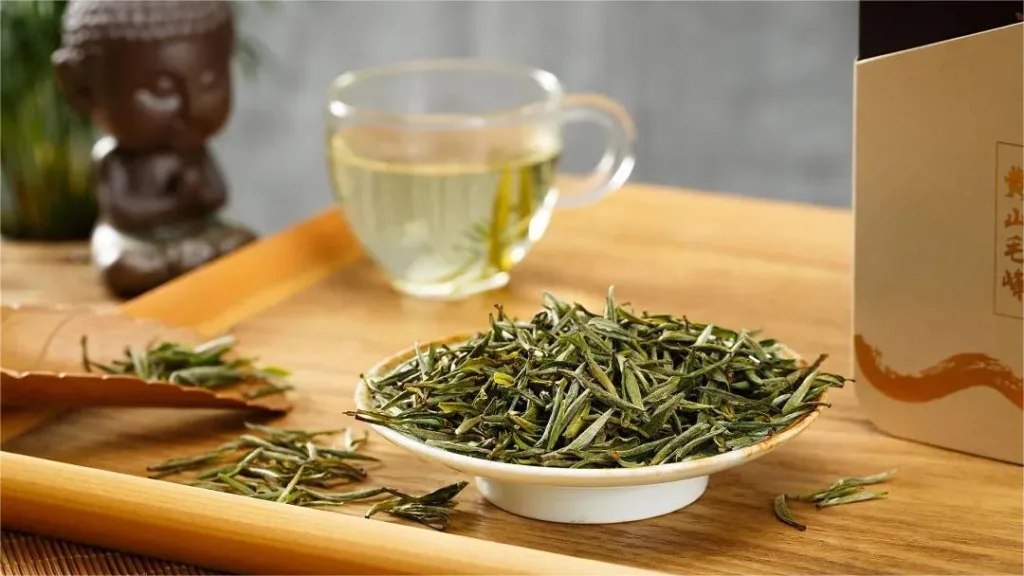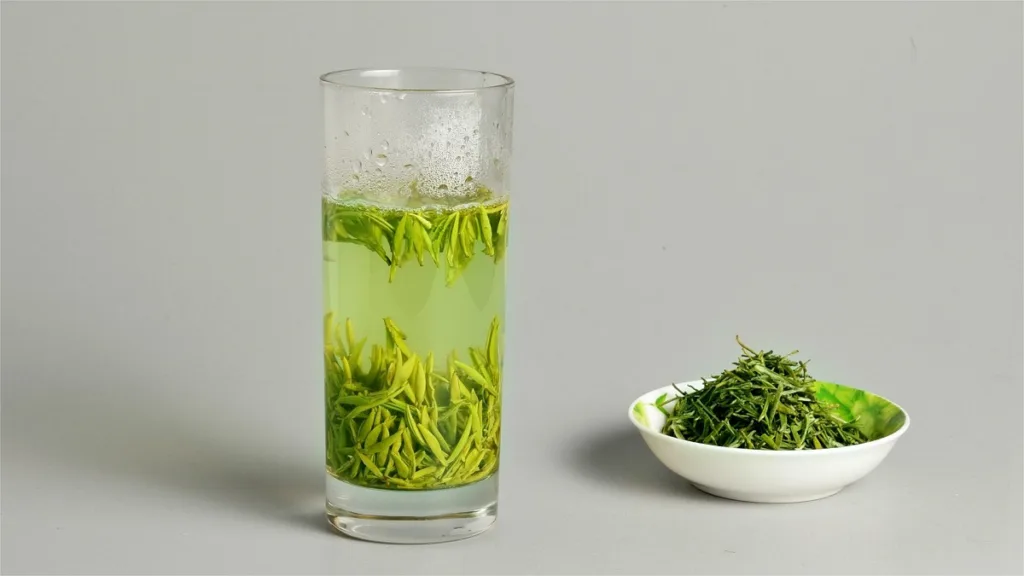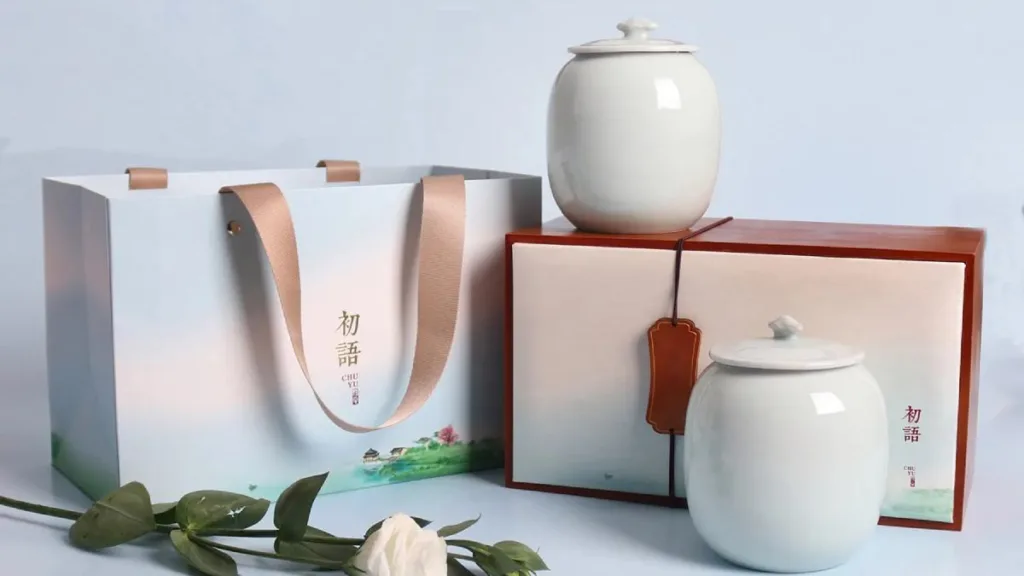Long Ding Green Tea, which originates from the Baiyun Mountain in the Qixi Township of Kaihua County, Zhejiang, is a remarkable representation of flat-leaf green tea. It is harvested between Clear and Grain Rain, carefully selecting the bud and the first or second leaf from the thriving and robust branches. The production process involves five essential steps: fixing, rolling, initial roasting, shaping, and final drying. Long Ding Green Tea stands out with its unique qualities, boasting a straight and slender appearance, covered with silver tips, a vibrant green color, a clear and lasting aroma accompanied by the scent of orchids, a rich and refreshing taste, a tender and uniform green infusion, and finely even leaf bottoms. Recognized as a rising star among Chinese teas, it earned the honor of “Famous Tea” in Zhejiang Province’s tea evaluation in 1985, awarded by the Food Industry Association. That same year, it was also designated as one of China’s national famous teas.
History
In the late Yuan Dynasty, Zhu Yuanzhang, who would later become the founding emperor of the Ming Dynasty, led his army to the mountaintop of Dalong in the Qixi Township of Kaihua County. Feeling thirsty, he was presented with a bowl of freshly brewed tea by an old tea farmer. After sipping it, Zhu Yuanzhang was overwhelmed by the exquisite flavor, feeling revitalized and clear-minded. He immediately asked the old tea farmer, “Where is this tea from?” The farmer replied, “It’s grown near ‘Long Ding Tan’ by the Big Dragon Mountain.” Zhu Yuanzhang had a premonition of his future as the emperor and was elated, exclaiming, “I am drinking tea that grows by the Long Ding Tan near the peak of Big Dragon Mountain. Since the dragon resides at the mountain’s top, it’s a sign that I am the true emperor! Let’s name this tea ‘Long Ding Tea’!” And this is how Long Ding Tea got its name.
History of Kaihua Long Ding Tea
Kaihua County, situated at the junction of three provinces – Zhejiang, Anhui, and Jiangxi – forms the “Tea Golden Triangle.” The region is known for its high mountains, dense forests, and pristine environment, making it a perfect place for tea cultivation. During the Ming and Qing Dynasties, Kaihua bud tea was a tribute to the imperial court. According to the “Kaihua County Chronicles,” in 1631, “four catties of tribute bud tea” were presented in the fourth year of the Chongzhen era. In 1898, tribute bud tea was recorded as “restricted to be packed in yellow silk and handled in baskets.” Kaihua Long Ding Tea is crafted from fresh one bud or one bud and one leaf leaves, resulting in a straight and elegant appearance. It’s known for its “high fragrance, mellow taste, and prolonged steeping.” Moreover, it boasts the unique “Three Greens” characteristics: the dry leaves are green, the liquor is clear and green, and the wet leaves are fresh green. The excellent quality and rich cultural heritage of Long Ding Tea offer a lifestyle of elegance and leisure. During moments of leisure, savoring Long Ding Tea with its lingering mist and delightful aroma, enjoying it slowly, and contemplating its taste is a fashionable choice for a well-rounded life.
Proper Brewing Methods
- Use a ceramic teapot or cup: When brewing tea, it is advisable to use a ceramic teapot or cup, rather than an insulated container. Using an insulated container for steeping tea can result in the tea retaining high temperatures for an extended duration, causing a loss of some of its aromatic oils and a diminished aroma. This can also lead to an excessive amount of tannins and caffeine being dissolved in the tea, which can make it taste bitter.
- Use water just below boiling: Boiling water can damage many of the tea’s nutrients. For example, vitamins such as vitamin C and P start to degrade when the water temperature exceeds 80°C (176°F). Furthermore, boiling water can dissolve too many tannins and make the tea taste bitter. Therefore, it is recommended to steep tea at a water temperature between 70°C-80°C (158°F-176°F). This is especially important for green tea, as excessively high temperatures can turn it into black tea, depriving it of its original freshness and crispness.
- Steep for the right amount of time: Tea leaves are best steeped for 4-6 minutes. Steeping tea for too long can make the tea taste overly bitter. If tea is left on a warming plate or stove for a prolonged period, it can undergo chemical changes and should not be consumed.
- Don’t discard used tea leaves: Instead of throwing away used tea leaves, which is wasteful, it’s advisable to chew and swallow them. Tea leaves contain various nutrients, including carotene, dietary fiber, and other beneficial compounds.
- Avoid brewing overly strong tea: To brew a cup with the right strength, you typically need around 10 grams of tea leaves. Some individuals prefer stronger tea, but excessive strength can result in a harsher taste due to an overabundance of caffeine and tannins, which can irritate the stomach. After steeping one cup of tea, you can continue steeping the tea leaves to brew 3-4 additional cups.
Health Benefits
In general, Long Ding Tea offers several health benefits and functions, including mental alertness, diuretic effects, dental cavity prevention, atherosclerosis inhibition, and weight loss support. The specific effects are as follows:
- Mental Alertness: The caffeine in Long Ding Tea can stimulate the central nervous system, helping to invigorate the mind, enhance cognitive functions, eliminate fatigue, and improve work efficiency.
- Diuretic Effects: Long Ding Tea contains caffeine and theobromine, which can stimulate the kidneys, promoting the rapid excretion of urine, increasing the glomerular filtration rate, and reducing the time harmful substances remain in the kidneys.
- Dental Cavity Prevention: Long Ding Tea contains fluoride ions, which have a strong affinity for the calcium ions in teeth. This can lead to the formation of “fluorapatite,” a less soluble compound in acid, acting as a protective layer that enhances the tooth’s acid resistance and cavity prevention.
- Atherosclerosis Inhibition: The tea polyphenols and vitamin C present in Long Ding Tea have properties that activate blood and dissipate stasis. This can help prevent the development of atherosclerosis. Individuals who frequently consume tea have a lower incidence of hypertension and coronary atherosclerotic heart disease.
- Weight Loss Support: The caffeine, inositol, folic acid, and pantothenic acid present in Long Ding Tea have effective properties for protein and fat decomposition. As a result, consuming Long Ding Tea can support weight loss efforts.
In conclusion, Long Ding Green Tea is a remarkable tea variety with a rich history and numerous health benefits. It is cherished for its unique flavor, and its proper brewing can maximize its qualities. Long Ding Tea, with its connection to Chinese history and culture, offers not only a delightful taste but also a sense of elegance and well-being. So, whether you are seeking mental alertness, diuretic effects, dental health, atherosclerosis prevention, or weight management, Long Ding Tea may be a valuable addition to your daily routine.




